Caracas

 Clash Royale CLAN TAG#URR8PPP
Clash Royale CLAN TAG#URR8PPP This article may be expanded with text translated from the corresponding article in Spanish. (March 2018) Click [show] for important translation instructions.
|
| Caracas | |||
|---|---|---|---|
Capital City | |||
Santiago de León de Caracas | |||
 | |||
| |||
Nickname(s): La Sultana del Ávila (The Avila's Sultana) La Sucursal del Cielo (Heaven's Branch on Earth) La Ciudad de la Eterna Primavera (The City of Eternal Spring) | |||
Motto(s): Muy Noble y Leal Ciudad | |||
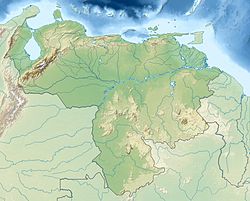 Caracas Location in Venezuela and South America Show map of Venezuela  Caracas Caracas (South America) Show map of South America | |||
Coordinates: 10°28′50″N 66°54′13″W / 10.48056°N 66.90361°W / 10.48056; -66.90361Coordinates: 10°28′50″N 66°54′13″W / 10.48056°N 66.90361°W / 10.48056; -66.90361 | |||
| Country | Venezuela | ||
| State | Capital District | ||
| Founded | 25 July 1567 | ||
| Founded by | Diego de Losada | ||
| Government | |||
| • Type | Mayor-council | ||
| • Body | Government of the Capital District | ||
| • Chief of Government | Carolina Cestari | ||
| Area | |||
| • Capital City | 433 km2 (167 sq mi) | ||
| • Metro | 4,715.1 km2 (1,820.5 sq mi) | ||
| Elevation | 900 m (3,000 ft) | ||
| Highest elevation | 1,400 m (4,600 ft) | ||
| Lowest elevation | 870 m (2,850 ft) | ||
| Population (2017)[1] | |||
| • Capital City | 1,945,901 | ||
| • Density | 4,212.9/km2 (10,911/sq mi) | ||
| • Metro | 2,967,626 | ||
| • Metro density | 1,123.4/km2 (2,910/sq mi) | ||
| Demonym(s) | Caraquenian (Spanish: caraqueño (m), caraqueña (f)) | ||
| Time zone | VST (UTC−04:00) | ||
| Postal codes [2] | 1000 - 1090, 1209 | ||
| Area code | 212 | ||
| ISO 3166 code | VE-A | ||
| Website | Capital District | ||
The area and population figures are the sum of the figures of the five municipalities (listed above) that make up the Distrito Metropolitano. | |||
Caracas (Spanish pronunciation: [kaˈɾakas]), officially Santiago de León de Caracas, is the capital and centre of the Greater Caracas Area, and the largest city of Venezuela. Caracas is located along the Guaire River in the northern part of the country, following the contours of the narrow Caracas Valley on the Venezuelan coastal mountain range (Cordillera de la Costa). Terrain suitable for building lies between 760 and 1,140 m (2,490 and 3,740 ft) above sea level, although there is some settlement above this range. The valley is close to the Caribbean Sea, separated from the coast by a steep 2,200-metre-high (7,200 ft) mountain range, Cerro El Ávila; to the south there are more hills and mountains. The Metropolitan Region of Caracas has an estimated population of 7,267,102.[citation needed]
Strictly speaking, the centre of the city is still "Catedral", located near Bolívar Square,[3] even though it is assumed that it is Plaza Venezuela, located in Los Caobos neighbourhood[4][5] and extends along the Boulevard of Sabana Grande to the east.[6] Chacaíto area, Luis Brión Square and El Rosal neighborhood are also considered the geographic center of the Metropolitan Region of Caracas,[7][8] commonly called "Greater Caracas". The political-administrative division of Caracas has not yet been updated, but the project has been discussed several times.[4]
Businesses in the city include service companies, banks, and malls. Caracas has a largely service-based economy, apart from some industrial activity in its metropolitan area.[9] The Caracas Stock Exchange and Petróleos de Venezuela (PDVSA) are headquartered in Caracas. PDVSA is the largest company in Venezuela. Caracas is also Venezuela's cultural capital, with many restaurants, theaters, museums, and shopping centers. Some of the tallest skyscrapers in Latin America are located in Caracas.[10]
Caracas has been considered one of the most important cultural, tourist, industrial and economic centers of Latin America. The Museum of Contemporary Art of Caracas is one of the most important in South America. The Museum of Fine Arts and the National Art Gallery of Caracas are also noteworthy.[11] The National Art Gallery is projected to be the largest museum in Latin America, according to its architect Carlos Gómez De Llarena.[12]Boulevard of Sabana Grande is the main commercial corridor of the city and is visited by more than 500 thousand people every day.[13] In 2011, the pedestrian space of Sabana Grande quadrupled.[14]Sabana Grande is a broad, tree-shaded, pedestrians-only boulevard lined on both sides with stylish fashion boutiques, gift shops and street art.[15][16]
Caracas is home to two of the tallest skyscrapers in South America: the Parque Central Towers. It has a nominal GDP of 91988 million dollars, a nominal GDP per capita of 18,992 and a PPP GDP per capita of 32,710 dollars. Being the seventh city in GDP and the seventh metropolitan area in population of Latin America. The Parque Central Towers still boast the title of the highest twin towers in Latin America, even though they are no longer the tallest skyscrapers in the region. In Caracas, the tallest skyscrapers are: Parque Central Towers, Banco Mercantil Building, BBVA Provincial Tower and The Twin Towers of El Recreo Shopping Mall in Sabana Grande district.[17] Most of these buildings are located in the center of the city. Unfortunately, Business Center Confinanzas was not completed. If so, it would be the third tallest skyscraper of Caracas.[10]
According to some sources, Caracas had the highest per capita murder rate in the world, with 119 homicides per 100,000 inhabitants.[18] Others have argued that the number of homicides in Venezuela has been inflated.[19][20][21][22] Most murders and other violent crimes apparently go unsolved.[23]
Contents
1 History
2 Symbols
3 Local government
3.1 Metropolitan District of Caracas
4 Economy
4.1 Cost of living
4.2 Tourism
5 Geography
5.1 Climate
6 Demographics
6.1 Crime
7 Landmarks
7.1 Federal Capitol
7.2 Boulevard of Sabana Grande
7.3 East Park
7.4 Teresa Carreño Cultural Complex
7.5 Simón Bolívar's Birthplace Home
7.6 National Pantheon
7.7 Parque Central Complex
7.8 Public squares
7.9 El Hatillo
7.10 Cerro El Ávila
7.11 Las Mercedes
7.12 Altamira neighborhood
7.13 Religious buildings
7.14 Landmarks
8 Colleges, universities and international schools
8.1 Central University of Venezuela
8.2 Simón Bolívar University
8.3 Other universities
8.4 International schools
9 Sports
9.1 Teams
10 Culture
10.1 Gastronomy
11 Notable people
12 Transportation
13 International relations
13.1 Twin towns and Sister Cities
13.2 Union of Ibero-American Capital Cities
14 Districts
15 See also
16 Notes and references
17 Bibliography
18 External links
History

Conqueror Diego de Losada, founder of Santiago de León de Caracas (painted early 20th century )
At the time of the founding of the city in 1567,[24] the valley of Caracas was populated by indigenous peoples. Francisco Fajardo, the son of a Spanish captain and a Guaiqueri cacica, attempted to establish a plantation in the valley in 1562 after founding a series of coastal towns. Fajardo's settlement did not last long. It was destroyed by natives of the region led by Terepaima and Guaicaipuro. This was the last rebellion on the part of the natives. On 25 July 1567, Captain Diego de Losada laid the foundations of the city of Santiago de León de Caracas. The foundation − 1567 – "I take possession of this land in the name of God and the King" These were the words of Don Diego de Losada in founding the city of Caracas on 25 July 1567. In 1577, Caracas became the capital of the Spanish Empire's Venezuela Province under Governor Juan de Pimentel (1576–1583).
During the 17th century, the coast of Venezuela was frequently raided by pirates. With the coastal mountains as a barrier, Caracas was relatively immune to such attacks. However, in 1595, around 200 English privateers including George Sommers and Amyas Preston crossed the mountains through a little-used pass while the town's defenders were guarding the more often-used one. Encountering little resistance, the invaders sacked and set fire to the town after a failed ransom negotiation.[25][26]
As the cocoa cultivation and exports under the Compañía Guipuzcoana de Caracas grew in importance, the city expanded. In 1777, Caracas became the capital of the Captaincy General of Venezuela.
José María España and Manuel Gual led an attempted revolution aimed at independence, but the rebellion was put down on 13 July 1797. Caracas was ultimately the site of the signing of a Declaration of Independence on 5 July 1811. In 1812, an earthquake destroyed Caracas. The independentist war continued until 24 June 1821, when Bolívar defeated royalists in the Battle of Carabobo.[27]
Caracas grew in economic importance during Venezuela's oil boom in the early 20th century. During the 1950s, Caracas began an intensive modernization program which continued throughout the 1960s and early 1970s. The Universidad Central de Venezuela, designed by modernist architect Carlos Raúl Villanueva and declared World Heritage by UNESCO, was built. New working- and middle-class residential districts sprouted in the valley, extending the urban area toward the east and southeast. Joining El Silencio, also designed by Villanueva, were several workers' housing districts, 23 de Enero and Simon Rodriguez. Middle-class developments include Bello Monte, Los Palos Grandes, Chuao, and El Cafetal. The dramatic change in the economic structure of the country, which went from being primarily agricultural to dependent on oil production, stimulated the fast development of Caracas, and made it a magnet for people in rural communities who migrated to the capital city in an unplanned fashion searching for greater economic opportunity. This migration created the rancho (slum) belt of the valley of Caracas.
Symbols
The flag of Caracas consists of a burgundy red field with the version of the Coat of Arms of the City (effective since the 1980s). The red field symbolises the blood spilt by Caraquenian people in favour of independence and the highest ideals of the Venezuelan Nation. Later, in the year 1994, presumably as a result of the change of municipal authorities, it was decided to increase the size of the Caracas coat of arms and move it to the centre of the field. This version of the flag is still in use today.
The coat of arms of the City of Caracas was adopted by the Libertador Municipality to identify itself. Later, the Metropolitan Mayor Office assumed the lion, the scallop and Saint James' Cross for the same purpose.
The anthem of the city is the Marcha a Caracas, written by the composer Tiero Pezzuti de Matteis with the lyrics by José Enrique Sarabia. The lyrics are said to be inspired by the heroism of the Caraquenian people, and the memory of the City of Red Roofs. Incidentally, the National Anthem of Venezuela, Gloria al Bravo Pueblo, includes the lines "...y si el despotismo levanta la voz, seguid el ejemplo que Caracas dio" ("...and if despotism raises its voice, follow the example that Caracas gave"), reflecting the fact that, in addition to generously providing many heroic fighters to the War of Independence, the junta established in Caracas (19 April 1810) served as inspiration for other regions to do the same—as did its declaration of independence a year later.
Local government
Under the constitution of Venezuela, municipal governments have two branches: the executive (governed by a mayor) and the legislative (managed by a municipal council).
Metropolitan District of Caracas
On 8 March 2000, the year after a new constitution was introduced in Venezuela, it was decreed in Gaceta Official N° 36,906 that the Metropolitan District of Caracas would be created, and that some of the powers of Libertador, Chacao, Baruta, Sucre, and El Hatillo municipalities would be delegated to the Alcaldía Mayor, physically located in the large Libertador municipality, in the center of the city.[28] The Metropolitan District of Caracas was suppressed on 20 December 2017 by the Constituent National Assembly of Venezuela.[29]
Economy

Business Center Sabana Grande (Centro Empresarial Sabana Grande), headquarter of Petrocaribe and PDVSA La Estancia (2018).
Businesses that are located here include service companies, banks, and malls, among others. It has a largely service-based economy, apart from some industrial activity in its metropolitan area.[9] The Caracas Stock Exchange and Petróleos de Venezuela (PDVSA) are headquartered here. The PDVSA is the largest company in Venezuela,[30] and negotiates all the international agreements for the distribution and export of petroleum.[31] When the company existed, the airline Viasa had its headquarters in the Torre Viasa.[32][33]
Several international companies and embassies are located in El Rosal and Las Mercedes, in the north of the Baruta municipality and the south of the Chacao municipality. Other important business districts include Sabana Grande (home to PDVSA, Citibank, El Recreo Shopping Mall, Petrocaribe, Gran Meliá Caracas, Banco Plaza, Torre Centrum, Centro Empresarial Sabana Grande, and many others), Chacao, Altamira, La Candelaria and Parque Central Complex. Boulevard of Sabana Grande is home to many fashion stores, such as: Balú, Planeta Sports, Mango, Angely and more. PDVSA is the main industry of Caracas. Central Bank of Venezuela is located in the center of the city, near La Candelaria. Parroquia El Recreo (Sabana Grande district) is the only place in Libertador Municipality) who host European embassies, such as the Embassy of Greece and the Embassy of Abkhazia.[citation needed]

Caracas Stock Exchange building in El Rosal district
Sabana Grande is the main shopping thoroughfare in Caracas. It is a broad, tree-shaded, pedestrians-only boulevard lined on both sides with stylish fashion boutiques, gift shops and street art. Nowadays, Balú is the most important store in Sabana Grande district.[citation needed]Those who need rest can sit on tree-shaded wooden benches that are placed along the length of the boulevard. Refreshments and/or quick-munch lunches can be bought from fast-food outlets and outdoor cafes sandwiched between the retail shops. Sabana Grande has been the bohemian district of Caracas and it has had many ups and downs in its history.
Small and medium-size industry contributes to the Caracas economy. The city provides communication and transportation infrastructure between the metropolitan area and the rest of the country. Important industries in Caracas include chemicals, textiles, leather, food, iron and wood products. There are also rubber and cement factories.[34] Its GDP(Nominal) is 70 billion USD and the GDP(PPP) per Capita is.USD 24,000 [35]
Cost of living
A 2009 United Nations survey reported that the cost of living in Caracas was 89% of that of the survey's baseline city, New York.[36] However, this statistic is based upon a fixed currency-exchange-rate of 2003 and might not be completely realistic, due to the elevated inflation rates of the last several years.[37] However, Caracas is now one of the cheapest cities for tourists, according to The Economist Intelligence Unit. Caracas is now the 132nd most expensive city in the world.[38]
Tourism
In 2013, the World Economic forum evaluated countries in terms of how successful they were in advertising campaigns to attract foreign visitors. Out of the 140 countries evaluated, Venezuela came last.[citation needed] Myriad factors contribute to the lack of tourism in Caracas. A major factor that has contributed to the lack of foreign visitors has been poor transport for tourists. Venezuela has limited railway systems and airlines. High crime rates and the negative attitude of the Venezuelan population towards tourism also contributed to the poor evaluation.
In an attempt to attract more foreign visitors, the Venezuelan Ministry of Tourism invested in multiple hotel infrastructures. The largest hotel investment has been in the Hotel Alba Caracas. The cost for the general maintenance of the north and south towers of the hotel is approximately 231.5 million Venezuelan bolivars.
Although the Venezuelan Ministry of Tourism has taken the initiative to recognize the importance of the tourism industry, the Venezuelan government has not placed the tourism industry as an economic priority. In 2013, the budget for the Ministry of Tourism was only 173.8 million bolivars, while the Ministry of the Youth received approximately 724.6 million bolivars.
The tourism industry in Venezuela contributes approximately 3.8 percent of the country GDP. Venezuela's current goal is to reach a GDP of 7.6 percent. The World Economic Forum predicts Venezuela's GDP to rise to 4.2 percent by 2022.[39]
Geography
Caracas is contained entirely within a valley of the Venezuelan central range, and separated from the Caribbean coast by a roughly 15 kilometres (9 miles) expanse of El Ávila National Park. The valley is relatively small and quite irregular, the altitude with respect to sea level varies from between 870 and 1,043 meters (2,854 and 3,422 ft)
, with 900 meters (3,000 feet) in the historic zone. This, along with the rapid population growth, has profoundly influenced the urban development of the city. The most elevated point of the Capital District, wherein the city is located, is the Pico El Ávila, which rises to 2,159 meters (7,083 feet). The main body of water in Caracas is the Guaire River, which flows across the city and empties into the Tuy River, which is also fed by the El Valle and San Pedro rivers, in addition to numerous streams which descend from El Ávila. The La Mariposa and Camatagua reservoirs provide water to the city.
The city is occasionally subject to earthquakes - notably in 1641 and 1967.
Day view of El Avila National Park from Parque del Este
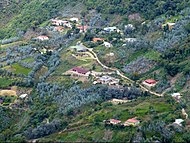
Galipán, town atop El Ávila

View of the Rio Guaire canyon, main body of water that passes through Caracas
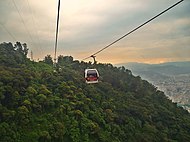
View of the Avila gondola lift starting from Caracas to Hotel Humboldt station
Climate

View of the east side of Caracas
Under the Köppen climate classification, Caracas has a tropical savanna climate (Aw). Caracas is also intertropical, with precipitation that varies between 900 and 1,300 millimeters (35 and 51 inches) (annual), in the city proper, and up to 2,000 millimeters (79 inches) in some parts of the Mountain range. While Caracas is within the tropics, due to its altitude temperatures are generally not nearly as high as other tropical locations at sea level. The annual average temperature is approximately 23.8 °C (75 °F), with the average of the coldest month (January) 22.8 °C (73 °F) and the average of the warmest month (July) 25.0 °C (77 °F), which gives a small annual thermal amplitude of 2.2 °C (4.0 °F). In the months of December and January abundant fog may appear, in addition to a sudden nightly drop in temperature, until reaching 8 °C (46 °F).[40] This peculiar weather is known by the natives of Caracas as the Pacheco. In addition, nightly temperatures at any time of the year are much (14 to 20 °C) lower than daytime highs and usually do not remain above 24 °C (75 °F), resulting in very pleasant evening temperatures. Hail storms appear in Caracas, although only on rare occasions. Electrical storms are much more frequent, especially between June and October, due to the city being in a closed valley and the orographic action of Cerro El Ávila. Caracas record extremes have been reported in other city's stations to reach a minimum of 6 °C (43 °F) and a maximum of 35.5 °C (95.9 °F)[41][better source needed][self-published source]
| Month | Jan | Feb | Mar | Apr | May | Jun | Jul | Aug | Sep | Oct | Nov | Dec | Year |
|---|---|---|---|---|---|---|---|---|---|---|---|---|---|
| Record high °C (°F) | 31.9 (89.4) | 34.1 (93.4) | 35.3 (95.5) | 33.5 (92.3) | 34.4 (93.9) | 32.8 (91) | 33.6 (92.5) | 31.5 (88.7) | 32.2 (90) | 31.4 (88.5) | 31.2 (88.2) | 30.8 (87.4) | 35.3 (95.5) |
| Average high °C (°F) | 23.3 (73.9) | 23.6 (74.5) | 24.3 (75.7) | 25.0 (77) | 25.8 (78.4) | 26.0 (78.8) | 25.5 (77.9) | 25.8 (78.4) | 25.5 (77.9) | 25.2 (77.4) | 24.6 (76.3) | 23.8 (74.8) | 24.9 (76.8) |
| Daily mean °C (°F) | 19.6 (67.3) | 19.7 (67.5) | 20.2 (68.4) | 21.2 (70.2) | 22.0 (71.6) | 22.0 (71.6) | 21.7 (71.1) | 21.9 (71.4) | 21.9 (71.4) | 21.8 (71.2) | 21.3 (70.3) | 20.2 (68.4) | 21.1 (70) |
| Average low °C (°F) | 15.9 (60.6) | 15.8 (60.4) | 16.0 (60.8) | 17.5 (63.5) | 18.2 (64.8) | 18.1 (64.6) | 17.9 (64.2) | 18.1 (64.6) | 18.3 (64.9) | 18.4 (65.1) | 18.0 (64.4) | 16.5 (61.7) | 17.4 (63.3) |
| Record low °C (°F) | 7.1 (44.8) | 10.9 (51.6) | 11.4 (52.5) | 12.5 (54.5) | 13.1 (55.6) | 14.9 (58.8) | 14.1 (57.4) | 14.3 (57.7) | 15.5 (59.9) | 13.1 (55.6) | 11.9 (53.4) | 10.0 (50) | 7.1 (44.8) |
| Average rainfall mm (inches) | 15.3 (0.602) | 13.2 (0.52) | 11.4 (0.449) | 59.2 (2.331) | 81.7 (3.217) | 134.1 (5.28) | 118.4 (4.661) | 123.8 (4.874) | 115.4 (4.543) | 126.3 (4.972) | 72.6 (2.858) | 41.4 (1.63) | 912.8 (35.937) |
| Average rainy days (≥ 1.0 mm) | 6 | 4 | 3 | 7 | 13 | 19 | 19 | 18 | 15 | 15 | 13 | 10 | 142 |
| Average relative humidity (%) | 73.7 | 74.2 | 73.0 | 76.3 | 75.4 | 75.1 | 74.1 | 74.0 | 74.9 | 74.7 | 73.7 | 74.7 | 74.5 |
| Mean monthly sunshine hours | 229.4 | 217.5 | 235.6 | 183.0 | 182.9 | 183.0 | 210.8 | 217.0 | 213.0 | 210.8 | 210.0 | 213.9 | 2,506.9 |
| Source #1: Instituto Nacional de Meteorología e Hidrología (INAMEH)[42][43] | |||||||||||||
| Source #2: World Meteorological Organization (rainfall data),[44] Hong Kong Observatory (sun only),[45] NOAA(extremes)[46] | |||||||||||||
Demographics
According to the population census of 2011 the Caracas proper (Distrito Capital) is over 1.9 million inhabitants,[47] while that of the Metropolitan District of Caracas is estimated at 2.9 million as of 2011[update]. The majority of the population is mixed-race, typically with varying degrees of European, African, Indigenous and occasional Asian ancestry. There is a noteworthy Afro-Venezuelan community formed by residents whose ancestors settled in Caracas after being liberated from slavery as a reward for aiding Bolívar in the Venezuelan War of Independence. Additionally, the city has a large number of both European Venezuelans & Asian Venezuelans who descend from the massive influx of various immigrants Venezuela received from all across Eurasia during the 20th century. The descendants of Spaniards, Portuguese, Italians, Chinese, Colombians, Germans, Syrians and Lebanese stand out.[47][48]

The geographic center of the Metropolitan Area of Caracas, Sabana Grande shopping district

Panoramic view of the Caracas valley from Parque Nacional El Ávila

Night view of East Caracas
Crime

The slums on the east and west hills of Caracas are the poorest neighborhoods in the city, and where crime tends to be concentrated.
Venezuela and its capital, Caracas, are reported to both have among the highest per capita murder rates in the world. Caracas is the city with the highest homicide rate in the world outside of a warzone, with a 2016 rate of around 120 murders per 100,000 people.[49][50][51][52][53][54] Most murders and other violent crimes go unsolved, with estimates of the number of unresolved crimes as high as 98%.[55][56][57] The U.S. Department of State has issued travel warnings for Venezuela (especially Caracas) due to high rates of crime.[58] However, even opposition intellectuals have stated that NGOs manipulate statistics. The NGO Observatorio Venezolano Para la Violencia created more than 6,000 deaths in a fictitious manner and that was demonstrated in 2016. [59]
Landmarks
Federal Capitol
The Federal Capitol occupies an entire city block, and, with its golden domes and neoclassical pediments, can seem even bigger. The building was commissioned by Antonio Guzmán Blanco in the 1870s, and is most famous for its Salón Elíptico, an oval hall with a mural-covered dome and walls lined with portraits of the country's great and good. The nearby Palacio Municipal de Caracas dating from 1696 was renovated in the Neoclassical style in 1906 and now serves as the city hall and the Caracas Museum.[60]
Boulevard of Sabana Grande

Boulevard of Sabana Grande, the main meeting place of Caracas.[15]
Sabana Grande district
Sabana Grande is the main shopping thoroughfare in Caracas Venezuela. It is a broad, tree-shaded, pedestrians-only boulevard lined on both sides with stylish fashion boutiques and gift shops. Those who need rest can sit on tree-shaded wooden benches that are placed along the length of the boulevard. Refreshments and/or quick-munch lunches can be bought from fast-food outlets and outdoor cafes sandwiched between the retail shops.
East Park
The Caracas East Park (Parque del Este, now officially Parque Generalísimo Francisco de Miranda) was designed by Brazilian architect Roberto Burle Marx. It is a green paradise in the middle of the city, and it contains a small zoo. A replica of the ship led by Francisco de Miranda, the Leander, is in the southern part of the park. Before there used to exist a replica of the Santa Maria ship, used by Christopher Colombus in his voyages to America.
Teresa Carreño Cultural Complex
The Teresa Carreño Cultural Complex (Complejo Cultural Teresa Carreño), or more commonly the Teresa Carreño Theatre (Teatro Teresa Carreño), is by far the most important theater of Caracas and Venezuela. The theater presents symphonic and popular concerts, operas, ballet, and dramatic works. It is the second largest theater in South America, after the Teatro Colón of Buenos Aires, Argentina.

Colonial painting of Our Lady of Caracas, Patroness of the city, and below the city (circa 1766).
Simón Bolívar's Birthplace Home
Skyscrapers may loom overhead, but there is more than a hint of original colonial flavor in this neatly proportioned reconstruction of the house where Simón Bolívar was born on 24 July 1783. The museum's exhibits include period weapons, banners and uniforms.
Much of the original colonial interior has been replaced by monumental paintings of battle scenes, but more personal relics can be seen in the nearby Bolivarian museum. The pride of the place goes to the coffin in which Bolívar's remains were brought from Colombia; his ashes now rest in the National Pantheon.
National Pantheon
Venezuela's most venerated building is five blocks north of Plaza Bolívar, on the northern edge of the old town. Formerly a church, the building was given its new purpose as the final resting place for eminent Venezuelans by Antonio Guzmán Blanco in 1874.
Parque Central Complex
At a short distance east of Plaza Bolívar is Parque Central, a concrete complex of five high-rise residential slabs of somewhat apocalyptic-appearing architecture, crowned by two 56-storey octagonal towers, one of them is under repair due to the fire which burnt the building on 17 October 2004.
Parque Central is Caracas' art and culture hub, with museums, cinemas and the Teresa Carreño Cultural Complex. The West Tower balcony, on the 52nd floor, gives a 360° bird's-eye view of Caracas.
Public squares
Plaza Bolívar is the focus of the old town with the monument to El Libertador, Simón Bolívar, at its heart. Modern high-rise buildings have overpowered much of the colonial flavor of Caracas' founding neighbourhood.
Plaza Venezuela is the geographic center of Caracas. It is a large urban plaza at the entrance of the Central University of Venezuela. Kinetic artists have displayed their works there, including Carlos Cruz-Diez, Alejandro Otero and Jesus Soto. East of the Plaza is the Plaza Venezuela Fountain, a large computerized display of water, music and colored light refurbished in 2009 to include the latest available technology.[61]
Plaza Caracas was constructed in 1983. It is in the Simón Bolívar Center.
Plaza San Jacinto dates to 1603 and used to be the site of the city market
Plaza Los Palos Grandes is a modern construction located at the municipality of Chacao. It has a display of water and a beautiful coffee shop. this plaza is the center of free yoga lessons for all the people that want to enjoy the city outdoors. It also has its own library.
El Hatillo
El Hatillo is a colonial town that is located at the south-east suburbs of Caracas in the municipal area of the same name. This small town, which is one of Venezuela's few well-preserved typical colonial areas, gives an idea of what Caracas was like in centuries past.
Cerro El Ávila
Cerro El Ávila (Mountain El Ávila) (Indigenous name: Waraira Repano), is a mountain in the mid-North of Venezuela. It rises next to Caracas and separates the city from the Caribbean Sea. It is considered the lungs of Caracas due to the amount of vegetation on the mountain.
Las Mercedes
This zone contains restaurants with varied gastronomical specialties, along with pubs, bars, pools and art galleries.
Altamira neighborhood
Altamira is a neighborhood in the Chacao municipality of Caracas. It has its own Metro Station, many hotels, malls and restaurants, and is an important business and cultural centre. The Francisco de Miranda avenue (a major avenue in Caracas) and the Distibuidor Altamira (a congested highway exit) are both in Altamira.

Caracas, as painted by Joseph Thomas in 1839
Religious buildings

Caracas cityscape in the early 1900s.
The Iglesia de San Francisco is of historical value. Bolívar's funeral was held here twelve years after his death. Here he was proclaimed Libertador in 1813 by the people of Caracas. The church has gilded baroque altarpieces, and retains much of its original colonial interior, despite being given a treatment in the 19th century under the auspices of Antonio Guzmán Blanco, which was intended to be modernizing.[citation needed] It contains some 17th-century masterpieces of art, carvings, sculptures and oil paintings. The Central University of Venezuela, established during the reign of Philip V, was lodged for centuries in the church cloisters next door, which today are the seat of the Language Academy, and the Academies of History, Physics, and Mathematics.
Caracas Cathedral is the seat of the Roman Catholic Archdiocese of Caracas. Basilica of St. Teresa is designated a National Historic Landmark.
The Mosque of Sheikh Ibrahim Al-Ibrahim is the second largest mosque in Latin America. For many years it was the biggest.[62]
The Union Israelita de Caracas is the biggest Synagogue for the Jewish Ashkenazi community in Caracas. Its mission is to host the religious services and preserve the memory of the Jewish heritage in Venezuela. Similarly, Los Caobos the biggest Synagogue for the Jewish Sephardic community in Caracas.
Landmarks
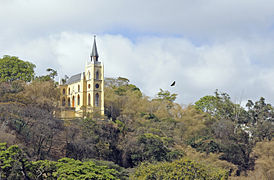
Lourdes Chapel

Palacio de las Academias

Boulevard of Sabana Grande

Central University of Venezuela
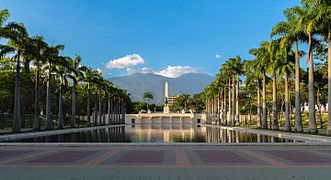
Paseo Los Proceres

Federal Capitol
Parque Cristal

Teresa Carreño Cultural Complex

Aerial view of Plaza Altamira
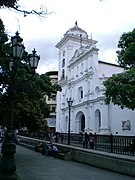
Caracas Cathedral
Parque del Este
Colleges, universities and international schools

Central University of Venezuela
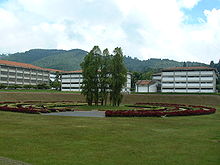
Laberinto Cromovegetal, at the Simón Bolívar University

Aerial view of Universidad Metropolitana
Central University of Venezuela
The Central University of Venezuela (Universidad Central de Venezuela in Spanish) is a public University. Founded in 1721, it is the oldest university in Venezuela and one of the first in Latin America.[citation needed] The university campus was designed by architect Carlos Raúl Villanueva and it was declared World Heritage by UNESCO in 2000. The Ciudad Universitaria de Caracas, as the main Campus is also known, is considered a masterpiece of architecture and urban planning and it is the only university campus designed in the 20th century that has received such recognition by UNESCO.[citation needed]
Simón Bolívar University
The Simón Bolívar University (Universidad Simón Bolívar, in Spanish, or USB) is a public institution in Caracas that focuses on science and technology. Its motto is "La Universidad de la Excelencia" ("University of Excellence").
Other universities
- Academia Militar de Venezuela
- Escuela de Formacion de Oficiales de las Fuerzas Armadas de Cooperación
- Universidad Alejandro de Humboldt
- Universidad Bolivariana de Venezuela
- Universidad Católica Andrés Bello
- Universidad Experimental Politécnica Antonio José de Sucre
- Universidad José María Vargas
- Universidad Metropolitana
- Universidad Monteavila
Universidad Nacional Experimental de las Fuerzas Armadas (UNEFA)- Universidad Nacional Experimental Simón Rodríguez
- Universidad Nueva Esparta
- Universidad Pedagógica Experimental Libertador
- Universidad Santa Maria
International schools
- British School of Caracas
- Colegio Internacional de Caracas
- Escuela Campo Alegre
- International Christian School
- Tomchei Tmimim
- Lycée Français de Caracas - Colegio Francia
Sports

UCV Baseball Stadium
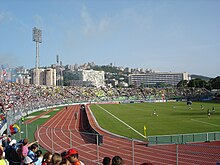
UCV Olympic Stadium
The city hosted the official 2013 Americas Basketball Championship.
There are professional association football, baseball and several other sports.
Professional teams include Caracas Fútbol Club, Deportivo Petare, Atletico Venezuela, SD Centro Italo Venezolano, Estrella Roja FC and Real Esppor Club. The Deportivo Petare has reached the semifinals of international tournaments, such as the Copa Libertadores de America, while the Caracas Fútbol Club has reached the quarterfinals.
Baseball teams Tiburones de La Guaira and Leones del Caracas play in the Estadio Universitario de la UCV, of the Central University of Venezuela, with a capacity of 26,000 spectators.
Another baseball team started in Caracas: the Navegantes del Magallanes. It was moved to Valencia, Carabobo in the 1970s.
Association Football stadiums include:
Estadio Olímpico de la UCV, with capacity of 30 000 spectators is seat of the Deportivo Italia and Caracas Fútbol Club.
Brígido Iriarte stadium, with a capacity of 12 000 spectators (old seat of the Deportivo Italia and Caracas Fútbol Club, and seat of the Estrella Roja FC). The Caracas Fútbol Club opened its own stadium in 2005, Campo Deportivo Cocodrilos.
Cocodrilos de Caracas plays in the Venezuelan professional basketball league. They play their games in the "Gimnasio José Beracasa" in the neighbourhood of El Paraíso.
Caracas is the seat of the National Institute of Sports and of the Venezuelan Olympic Committee.
Caracas hosted the 1983 Pan American Games.
Teams
- Association Football: Caracas Fútbol Club, Deportivo Petare, Atletico Venezuela, SD Centro Italo Venezolano, Estrella Roja Futbol club, Real Esppor Club.
- Baseball: Tiburones de la Guaira, Leones del Caracas.
- Basketball: Cocodrilos de Caracas.
Culture
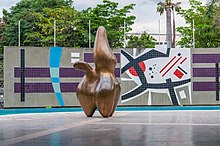
Cloud Shepherd, by Hans Arp, UCV
Caracas is Venezuela's cultural capital, with many restaurants, theaters, museums, and shopping centers. The city is home to many immigrants from Spain, Italy, Portugal, the Middle East, Germany, China, and Latin American countries.[63][64][65][66]
Gastronomy
Caracas has a gastronomical heritage due to the influence of immigrants, leading to a choice of regional and international cuisine. There are a variety of international restaurants including American, French, Lebanese, Italian, Spanish, Indian, Chinese, Peruvian, Japanese, Mediterranean and Mexican. The district of Sabana Grande contains Spanish, Italian, Arab and Chinese restaurants. Urrutia, La Huerta, Da Guido and El Arabito are very popular in Sabana Grande. The district of La Candelaria contains Spanish restaurants, resulting from Galician and Canarian immigrants that came to the area in the mid-20th century.
Notable people
Transportation

Inside Plaza Venezuela station of the Caracas Metro

Railway Caracas - Cúa
- The Caracas Metro has been in operation since 27 March 1983. With 4 lines, 47 stations and about 10 more to be constructed. It covers a great part of the city and also has an integrated ticket system that combines the route of the Metro with those offered by the Metrobús, a bus service of the Caracas Metro. In 2010, the first segment of a new ariel cable car system opened, Metrocable[67] which feeds into the larger metro system.
- Buses are the main means of mass transportation. There are two bus systems: the traditional system and the Metrobús. The traditional system runs a variety of bus types, operated by several companies on normal streets and avenues:
- Autobus; large buses
- Camioneta; medium size buses
- microbus or camionetica; vans or minivans
IFE; train services to and from Tuy Valley cities of Charallave and Cúa
Simón Bolívar International Airport, the biggest and most important in the country is located outside the city, roughly 32 kilometres (20 mi) from the downtown area.- Caracas Aerial Tramway
- The Los Teques Metro is a suburban mass-transit system completed in 2006 that connects Caracas with the suburban city of Los Teques.
- In March 2009 four of the five Caracas districts launched Plan Vía Libre to reduce traffic (the pro-Chavez Jorge Rodríguez' Libertador District is currently not cooperating as the other districts are in the hands of the opposition[68]). On each weekday, cars with certain number plates are banned from entering key parts of the city centre; the numbers rotate so that any particular car is banned one day a week.[69]
- Generalisimo Francisco de Miranda airbase used by military aviation and govern aeroplane
International relations
Twin towns and Sister Cities
Caracas is twinned with:[citation needed]
 Honolulu, USA[70]
Honolulu, USA[70] New Orleans, USA[70]
New Orleans, USA[70] Melilla, Spain[71]
Melilla, Spain[71] Rosario, Argentina, since 1998[72]
Rosario, Argentina, since 1998[72] Santa Cruz de Tenerife, Spain, since 1981[73]
Santa Cruz de Tenerife, Spain, since 1981[73]
Union of Ibero-American Capital Cities
Caracas is part of the Union of Ibero-American Capital Cities[74] from 12 October 1982 establishing brotherly relations with the following cities:
 Andorra la Vella, Andorra
Andorra la Vella, Andorra Asunción, Paraguay
Asunción, Paraguay Bogotá, Colombia
Bogotá, Colombia Buenos Aires, Argentina
Buenos Aires, Argentina Caracas, Venezuela
Caracas, Venezuela Guatemala City, Guatemala
Guatemala City, Guatemala Havana, Cuba
Havana, Cuba Quito, Ecuador
Quito, Ecuador La Paz, Bolivia
La Paz, Bolivia Lima, Peru
Lima, Peru Lisbon, Portugal
Lisbon, Portugal Madrid, Spain[75]
Madrid, Spain[75] Managua, Nicaragua
Managua, Nicaragua Mexico City, Mexico
Mexico City, Mexico Montevideo, Uruguay
Montevideo, Uruguay Panama City, Panama
Panama City, Panama Rio de Janeiro, Brazil
Rio de Janeiro, Brazil San Jose, Costa Rica
San Jose, Costa Rica San Juan, Puerto Rico
San Juan, Puerto Rico San Salvador, El Salvador
San Salvador, El Salvador Santiago, Chile
Santiago, Chile Santo Domingo, Dominican Republic
Santo Domingo, Dominican Republic Tegucigalpa, Honduras
Tegucigalpa, Honduras
Districts
See also
- 1641 Caracas earthquake
- 1967 Caracas earthquake
- Greater Caracas
- Large Cities Climate Leadership Group
- List of metropolitan areas of Venezuela
- Venezuela International Book Fair
Caracazo – a riot- Venezuela 60-day state of emergency
- List of cities with the most high-rise buildings
Notes and references
^ "Population projection for federal entities" (PDF). Archived from the original on 9 October 2012. Retrieved 30 April 2010.
^ "Postal Codes in Caracas". Páginas Amarillas Cantv. Retrieved December 30, 2015.
^ Martín Frechilla, Juan José (2004). Diálogos reconstruidos para una historia de la Caracas moderna. Caracas, Venezuela: CDCH UCV.
^ ab "Caracas, Presente y Futuro: Ideas para Transformar una Ciudad". Alcaldía de Caracas. 1995.
^ "Plaza Venezuela (Caracas) - Ciberturista". Ciberturista (in Spanish). 2010-01-20. Retrieved 2018-05-14.
^ Rodríguez, Verónica; Valero, Carla. "Una rayuela que se borra y se vuelve a dibujar cada día. Semblanza de lugar sobre la transformación urbanística y cultural de Sabana Grande" (PDF). Tesis de grado. Retrieved 15 March 2018.
^ Velásquez, Carmen (2004). "Espacio público y movilidad urbana. Sistemas Integrados de Transporte Masivo (SITM)" (PDF). Universitat de Barcelona.
^ ""¡Bienvenidos al oeste!", así recibieron vecinos a marcha que salió de Chacaito - Efecto Cocuyo". Efecto Cocuyo (in Spanish). 2017-04-22. Retrieved 2018-05-14.
^ ab
"Caracas". Caracas.eluniversal.com. Archived from the original on 3 September 2008. Retrieved 30 April 2010.
^ ab "The Skyscraper Center". www.skyscrapercenter.com. Retrieved 2018-05-03.
^ Valentina Quintero. 1998. Venezuela. Corporación Venezolana de Turismo. Caracas. 118p.
^ http://lisablackmore.net/?p=1004
^ http://caracasen450.com/2017/06/19/bulevar-de-sabana-grande/
^ "70% del bulevar será área peatonal - Caracas - EL UNIVERSAL". archivo.eluniversal.com.
^ ab Andrade Racenis, Vanessa (September 2004). "Sabana Grande Punto de Encuentro" (PDF). Tesis de grado. p. 60. Retrieved 10 March 2018.
^ MERIN, JENNIFER (1989-11-05). "A Leisurely Approach to Fashionable Caracas". Los Angeles Times. ISSN 0458-3035. Retrieved 2018-05-10.
^ "Caracas The Skyscraper Center". www.skyscrapercenter.com. Retrieved 2018-05-01.
^ "The Most Dangerous Cities in the World".
^ "Cómo contar nuestros muertos; por Dorothy Kronick « Prodavinci". historico.prodavinci.com (in Spanish). Retrieved 2018-05-12.
^ "Is Violence in Venezuela Leveling Off?". InSight Crime. 2016-07-04. Retrieved 2018-05-12.
^ "Venezuela's Violent Death Rate is Probably 20% Lower than Estimated - Venezuelan Politics and Human Rights". Venezuelan Politics and Human Rights. 2016-07-01. Retrieved 2018-05-12.
^ "Could it be that the murder rate did peak in 2008? | Caracas Chronicles". Caracas Chronicles. 2014-01-30. Retrieved 2018-05-12.
^
"24,000 murders last year confirm Venezuela as one of the world's most dangerous countries". The Guardian. 11 January 2014. Retrieved 31 May 2017.
^ Chisholm, Hugh, ed. (1911). "Carácas". Encyclopædia Britannica (11th ed.). Cambridge University Press.
Chisholm, Hugh, ed. (1911). "Carácas". Encyclopædia Britannica (11th ed.). Cambridge University Press.
^ John Lombardi, Venezuela, Oxford, England, 1982, p 72.
^
"George Somers, Amyas Preston and the Burning of Caracas". The Bermudian. Archived from the original on 13 May 2016. Retrieved 17 May 2016.
^ Maurice Wiesenthal, The History and Geography of a Valley, 1981.
^ Goldfrank, Benjamin (2011). Deepening Local Democracy in Latin America: Participation, Decentralization, and the Left. Penn State Press. p. 190. ISBN 978-0-271-07451-1.
^ "ANC aprobó supresión y liquidación del Área Metropolitana de Caracas" (in Spanish). El Nacional. 20 December 2017. Retrieved 21 April 2018.
^ "Sitio Web PDVSA". Pdvsa.com. Retrieved 26 June 2010.
^ "Petróleos de Venezuela S.A." PDVSA. Retrieved 26 June 2010.
^ "World Airline Directory." Flight International. 30 March 1985. 130." Retrieved on 17 June 2009.
^ "World Airline Directory." Flight International. 26 March 1988. 125.
^ "CIA - The World Factbook". Cia.gov. Retrieved 16 March 2012.
^ "The Online Journal of McKinsey & Company". McKinsey Quarterly. Retrieved 12 March 2013.
^ "Archived copy" (PDF). Archived from the original (PDF) on 24 December 2009. Retrieved 2009-09-18.
^ En_eco_art_venezuela With The H_13A884453 - 2007 - El Universal Archived 12 January 2014 at the Wayback Machine.
^ "Caracas entre las ciudades más baratas para turistas". El Venezolano de Orlando. [dead link]
^ MARTÍNEZ RODRÍGUEZ, M. (2013). Venezuela: un destino nada chévere. Debates IESA, 18(4), 73-75.
^ "Weather Base – World Weather – Average Conditions – Caracas". BBC. Retrieved 28 July 2013.
^ http://www.mherrera.org/temp.htm Extreme temperatures around the world
^ "Estadísticos Básicos Temperaturas y Humedades Relativas Máximas y Mínimas Medias" (PDF). INAMEH (in Spanish). Archived from the original (PDF) on 15 June 2013. Retrieved 31 July 2012.
^ "Estadísticos Básicos Temperaturas y Humedades Relativas Medias" (PDF). INAMEH (in Spanish). Archived from the original (PDF) on 15 June 2013. Retrieved 31 July 2012.
^ "World Weather Information Service - Caracas". World Meteorological Organization. Retrieved 16 October 2012.
^ "Climatological Information for Caracas, Venezuela". Hong Kong Observatory. Retrieved 16 October 2012.
^ "Caracas-La-Carlota Climate Normals 1961-1990". National Oceanic and Atmospheric Administration. Retrieved 15 January 2013.
^ ab "Archived copy" (PDF). Archived from the original (PDF) on 9 October 2012. Retrieved 2010-04-30.
^ Censo Nacional Deciembre 2014
^ "List of cities by murder rate". seguridadjusticiaypaz.org.mx. Retrieved 26 January 2016.
^ "Most Dangerous Cities in the World". WorldAtlas.
^ Tait, Robert. "Caracas, Venezuela named as the world's most violent city". The Telegraph. Retrieved 22 April 2017.
^ Grillo, Ioan. "Venezuela's Murder Epidemic Rages on Amid State of Emergency". TIME. Retrieved 22 April 2017.
^ Tegel, Simeon. "Venezuela's capital is world's most murderous city". USA Today. Retrieved 22 April 2017.
^ "Caracas World's Most Violent City: Report". Insight Crime. Retrieved 22 April 2017.
^ Woody, Christopher. "Venezuela admits homicides soared to 60 a day in 2016, making it one of the most violent countries in the world". Business Insider.
^ "'98% Impunity Rate in Venezuela': Opposition". InSight crime. Retrieved 22 April 2017.
^ Mendoza, Samuel. "Impunity and insecurity go hand in hand in Venezuela". El Universal. Retrieved 22 April 2017.
^ "Venezuela Travel Warning". U.S. Department of State. Archived from the original on 16 June 2017. Retrieved 16 June 2017.
^ "La respuesta de Dorothy Kronick a la réplica que hizo el OVV sobre las cifras de homicidios en Venezuela « Prodavinci". historico.prodavinci.com (in Spanish). Retrieved 2018-04-21.
^ "Palacio Municipal de Caracas", EcuRed. (in Spanish) Retrieved 20 May 2013.
^ (in Spanish) VTV Noticias "Con gran explosión de luz, sonido y movimiento fue reinaugurada fuente de Plaza Venezuela". vtv.gov.ve. Archived from the original on 2 November 2009. Retrieved 13 December 2009.
^ The New York Times/ Brooke, James (3 January 1993). "Caracas Getting Continent's Biggest Mosque". The New York Times. Retrieved 13 December 2009.
^ Ingham, James (20 April 2007). "Americas | Airships to tackle Caracas crime". BBC News. Retrieved 7 July 2009.
^ "Venezuela". Travel.state.gov. Archived from the original on 11 January 2014. Retrieved 7 July 2009.
^ "Venezuela Warnings or Dangers – Travel Guide". VirtualTourist.com. Retrieved 7 July 2009.
^ Feinman, Sacha (27 November 2006). "Crime and class in Caracas. – By Sacha Feinman – Slate Magazine". Slate.com. Retrieved 7 July 2009.
^ "Caracas Metro Cable". www.urbanrail.net.
^ Gabriel, George. "Discourse and Division in Venezuela". venezuelanalysis.com. Retrieved 7 July 2009.
^ (in Spanish) Noticias24, 1 March 2009, Mañana comienza el "Plan Vía Libre" para combatir las colas en Caracas
^ ab "Caracas, Venezuela". Sister Cities International. Archived from the original on 10 February 2015. Retrieved 9 February 2015.
^ Terra. "Hermanamiento de Melilla con Caracas".
^ "Town Twinning Agreements". Municipalidad de Rosario - Buenos Aires 711. Retrieved 14 October 2014.
^ Santa Cruz más. "Ciudades hermanadas con Santa Cruz de Tenerife".
^ "Declaración de Hermanamiento múltiple y solidario de todas las Capitales de Iberoamérica (12-10-82)" (PDF). 12 October 1982. Archived from the original (PDF) on 10 May 2013. Retrieved 2015-03-12.
^ "Madrid International". Ayuntamiento de Madrid. Retrieved 22 July 2009.
Bibliography
External links
| Wikimedia Commons has media related to Caracas. |
 Caracas travel guide from Wikivoyage
Caracas travel guide from Wikivoyage

















